Gayle Irwin's Blog, page 5
August 24, 2020
Algal Blooms Can Poison Your Pets
 Blue-green and other algal blooms can poison pets that swim and play in lakes and other waterways.
Blue-green and other algal blooms can poison pets that swim and play in lakes and other waterways.With summer winding down and Labor Day weekend on the horizon, many people hit the water for some last blasts at the lake or on the river.
Water sports, like boating, fishing, canoeing, water skiing, kayaking, and paddle boarding are popular in the United States. And people often take their pets, primarily their dogs, on these adventures.
Many dogs enjoy the water. However, there are hazards, including drowning, that can occur. Therefore, it’s wise to have your pet wear a water safety vest anytime it’s near a body of water.
There is also another major hazard, especially on lakes: blue-green algae.
For the past several years, algae blooms have impacted American waterways. This slimy material can make both people and pets very ill and can even kill our beloved animals.
According to the Minnesota Pollution Control Agency (MPCA), “Blue-green algae blooms can occur anytime during the summer, though they are normally associated with warm weather and low rainfall.” Although algae are naturally part of an ecosystem, “under certain conditions, algae populations can ‘bloom’ with dramatic growth.” And though most are not toxic, “there is no way to visually identify whether a particular bloom contains toxins that are harmful to people or animals.”
Earlier this month, the state of Montana began placing warning signs at popular bodies of water, such as Canyon Ferry near Helena, cautioning boaters and other water users regarding harmful algal blooms (HABs). “The goal of the Montana HAB Program is to educate people about the potential dangers of HABs, how to identify them and how to respond,” said Hannah Riedl, water quality specialist at the Montana Department of Environmental Quality (DEQ).
 Paddle boarding and other water activities can be enjoyed by people and their pets. However, be aware of algal blooms which can harm both you and your dogs/cats.
Paddle boarding and other water activities can be enjoyed by people and their pets. However, be aware of algal blooms which can harm both you and your dogs/cats.Such blooms occur when waterways have excessive nutrient levels, such as phosphorus. When going to a lake, reservoir, or other waterway and you notice high levels of algae, avoid going into the water and keep your pet away as well. According to the MPCA, “If your dog does go into water with heavy algae growth, hose it off right away, before it has a chance to lick itself clean. Animals become ill when they ingest the toxins, so preventing them from drinking affected water or licking toxins from their coat is key to preventing illness.”
The most common signs of blue-green algae poisoning include:
VomitingDiarrheaWeaknessBreathing difficultiesDisorientationSeizuresBlood in stools
Without treatment, your dog could go into shock and a coma – and can die.
Find an informational guide here:
https://seagrant.sunysb.edu/btide/pdfs/HABsBrochure-0814.pdf
Learn more about blue-green algae and its potential impacts on humans and animals here:
https://www.petmd.com/news/health-science/dogs-and-toxic-algal-blooms-warning-pet-parents-36172
August 5, 2020
Helping Cats … or Hurting Them?
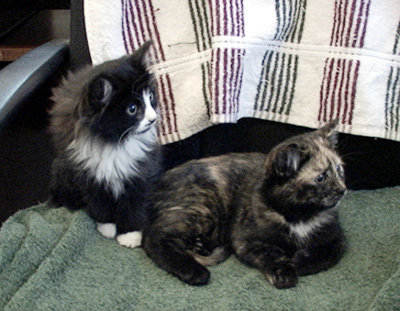 My cats Murphy and Bailey, who are sisters, when they were still kittens 15 years ago.
My cats Murphy and Bailey, who are sisters, when they were still kittens 15 years ago.My sister cats, Murphy and Bailey, turned 15 years old earlier this week. Their pregnant mom was trying to survive after being dumped on my friends’ ranch. Judy rescued mom, and the pretty Persian-looking cat gave birth to seven kittens two days later. One baby died, however, the other six grew healthy and strong. I took two females, a long-haired black and white we named Murphy, and a short-haired tortoiseshell we called Bailey.
 People often don’t reclaim their cats that come into shelters as lost pets. More cats than dogs are euthanized in animal shelters in the United States. Why are felines considered less valuable than canines in the adoption and reclaim arenas of our society?
People often don’t reclaim their cats that come into shelters as lost pets. More cats than dogs are euthanized in animal shelters in the United States. Why are felines considered less valuable than canines in the adoption and reclaim arenas of our society?Cats often get the short end of the stick when it comes to rescue and adoption. They are often abandoned or dumped on rural property, as the case of my girls’ mother. They may form communities or colonies, and city and town governments persecute them. People may find stray cats and take them to an animal shelter, where, sadly, many are euthanized. Cats are less likely to be claimed as strays than dogs, and though many are adopted, there is a high euthanasia rate for felines.
I came across a recent blog post from Best Friends Animal Society, one of the leading rescue organizations in America, and leader of the no-kill movement. If you are an animal lover, an advocate for pet rescue and adoption, and are especially attached to cats, I encourage you to read the blog post, which talks about how some of our best intentions may be killing hundreds, even thousands, of cats and kittens. Check it out here: https://bestfriends.org/blogs/2020/08/04/why-our-good-intentions-might-be-killing-more-1000-cats-and-kittens-every-day.
 My cat Murphy lounges in a new chair I set up in my home office earlier this year. She and her sister Bailey were truly rescued when my friend took in their mama, who was an abandoned cat that was pregnant.
My cat Murphy lounges in a new chair I set up in my home office earlier this year. She and her sister Bailey were truly rescued when my friend took in their mama, who was an abandoned cat that was pregnant.I’m grateful my friend Judy and her husband took in that mama cat 15 years ago. Murphy and Bailey and their siblings are the lucky ones — they found homes with kind, loving people, including Judy and her husband and me and my husband, who is also an animal lover and rescue supporter.
What can you do to help cats in your community?
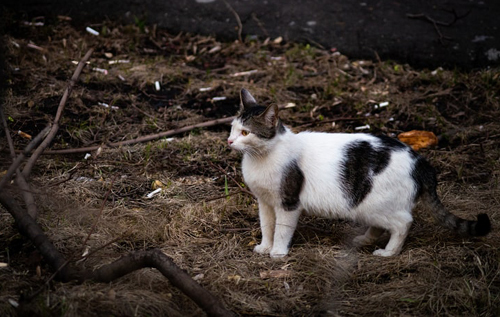 Every year, animal shelters across the country euthanize hundreds of thousands of cats, and colonies of abandoned cats are persecuted for what humans do to them — toss them aside. Can’t we, in 2020, do better by the animals that share our enivornments?
Every year, animal shelters across the country euthanize hundreds of thousands of cats, and colonies of abandoned cats are persecuted for what humans do to them — toss them aside. Can’t we, in 2020, do better by the animals that share our enivornments?
July 29, 2020
Ideas for Fun and Safe Road Trips with Your Pet
 Traveling with pets can present some challenges, but if you prepare ahead of time, such challenges lessen. Photo by
W W
from
Pexels
Traveling with pets can present some challenges, but if you prepare ahead of time, such challenges lessen. Photo by
W W
from
Pexels
As I traveled to visit my parents in Montana for my dad’s 84th birthday, I noticed numerous vehicles along the interstate, including many pulling RVs. Summer is in full swing, and many people travel during this time of year. Especially after a spring of lock down due to COVID-19, most of us are itching to “hit the road.” Whether for a trip that’s takes just a day, or a few hours, an extended weekend getaway, or a one week or more vacation, road tripping with your pet can be a welcome and wonderful time.
More lodging facilities and attractions allow dogs and cats than in years past. Even amid COVID numbers, owners of such facilities recognize the desire of people wanting to travel with pets. And, if you’re camping in a tent or an RV, numerous campgrounds allow animals as well.
 Whether you’re traveling with a dog or a cat, make sure you do your homework on the area you’re visiting and the lodging options you have for your pet. Photo by James Yarema on Unsplash
Whether you’re traveling with a dog or a cat, make sure you do your homework on the area you’re visiting and the lodging options you have for your pet. Photo by James Yarema on UnsplashBefore you hit the road, however, do your homework. Know before you go, as the saying goes. My husband and I recently traveled through Grand Teton National Park and the National Elk Refuge in western Wyoming. We stayed two nights at a cabin in Idaho, about 30 miles from Jackson. I chose this location for three reasons: 1. Pets are allowed; 2. Less expensive than Jackson; 3. Cabins instead of hotel rooms.
I researched the area before we embarked upon the trip to find this information. I also learned the rules of pets in the national park and on the national wildlife refuge. I discovered places to visit that were pet-friendly, and made sure there were walking areas nearby for strolling with the dogs. The trip was enjoyable … for us all.
We also recently took a day trip to South Dakota’s Custer State Park. Although I didn’t need to book lodging, we did need to ensure the park was pet-friendly and what the rules are for bringing pets to Custer State Park. We had not been there in several years and with recent changes in our country and our lives, I wanted to make sure we had the most up-to-date, accurate information about bringing pets to that area. Again, we enjoyed our long day-trip as did the dogs.
Besides finding information on a specific place from that site’s website (such as the National Park Service’s site for Grand Teton National Park or Custer State Park’s website), another great resource to check out is BringFido.com. This website provides listings of pet-friendly adventures, activities, lodging, and restaurants in different locations. However, when you find such facilities, I recommend you also contact the enterprise itself just because of the special circumstances of 2020. You will also find dog parks listed on BringFido.com.
 Depending upon your destination, some activities, like canoeing and kayaking, don’t allow pets. Check with the place where you plan to rent a boat, take a ferry, or participate in other activities that may or may not allow pets. Photo by Patrick Hendry on Unsplash
Depending upon your destination, some activities, like canoeing and kayaking, don’t allow pets. Check with the place where you plan to rent a boat, take a ferry, or participate in other activities that may or may not allow pets. Photo by Patrick Hendry on UnsplashIf plan an activity (such as a canoe rental) that doesn’t allow pets, another good resource is Rover.com. This site lists pet boarding/sitting services available in an area. A few years ago, my husband and I traveled to St. Louis to watch a Cardinals’ baseball game; we brought our two dogs on the trip and we used Rover.com to find a sitter for the evening while we attended the game. We’ve used the site several times since to get a sitter while we go to a concert or ballgame in another city.
Here are a few tips on things to bring when you travel with your pet:
Pack enough pet food – don’t count on picking up your pet’s favorite food along the journey as it may not be readily available. Also bring plenty of water and your furry friend’s food and water dishes.When road tripping with your cat, you’ll also need litter and the kitty’s litter box,Consider taking some of your pet’s toys and favorite blanket/bed. Having familiar items will help lessen your beloved pet’s stress.Does your pet take medication? Be sure that gets packed as well as contact information for your veterinarian. Don’t forget the leash, collar, and ID tag either.Make sure your pet’s vaccinations are up-to-date and carry a health certificate with you. Additionally, if your pet doesn’t travel well in the car, you may want to ask your veterinarian for a prescription to help keep your furry friend calmer.Carry a current photograph of your dog/cat with you. If your pet is lost during a trip, a photograph will make it easier for others to help you find your pet.Make frequent pit stops.Not only do you and your pet need bathroom breaks but taking a walk around the rest area helps both of you stretch your legs and get some fresh air.Never leave your dog/cat unattended in a parked vehicle. On warm days, the temperature in your vehicle can rise to 120 degrees in minutes, even with the windows slightly open. In addition, an animal left alone in a vehicle is an open invitation for pet thieves.
 Pets left in hot cars often spells trouble — just like you shouldn’t leave a child in a car, do not leave your pets there, either. Photo by
Charles Roth
from
Pexels
Pets left in hot cars often spells trouble — just like you shouldn’t leave a child in a car, do not leave your pets there, either. Photo by
Charles Roth
from
Pexels
Road tripping with your furry friend can be fun. Ensure it’s a safe time together, too, whether it’s a day trip or an extended vacation.
July 21, 2020
Water Fun and Safety for Pets
 Water activities can be enjoyable for many pets, especially dogs, but cautions need to be taken by pet parents to ensure their beloved animal’s safety.
Water activities can be enjoyable for many pets, especially dogs, but cautions need to be taken by pet parents to ensure their beloved animal’s safety.Paddleboarding, canoeing, kayaking, swimming, boating, and fishing – all fun summer water activities a person can enjoy with their pet. However, keep in mind: safety first, for both you and your furry companion!
Pets can drown, including dogs. Contrary to what many people think, not all dogs swim or swim well. Even the best of swimmers, like Labrador retrievers, can lose their lives in the water, especially a swollen, fast-moving river or stream. A person can give CPR to an animal that is pulled from the water, so knowing how to do that can be life-saving. If you and your pet are near racing water, please keep your furry friend on a leash.
 When on or near water, having a personal floatation device (PFD) can help prevent your pet from drowning.
When on or near water, having a personal floatation device (PFD) can help prevent your pet from drowning.Like many people, most dogs enjoy a great swim – it’s good exercise and helps alleviate some of the summer heat. However, swimming is also dangerous, especially when the water is high. Snow continues to melt in higher elevations; therefore, rivers and streams may continue to pose hazards to both people and pets. When camping, hiking, fishing, or boating this summer, keep your pet close at hand and restrained so that you control how close s/he gets to fast-moving water.
When canoeing, kayaking, boating, or paddleboarding, have your dog or cat wear a life jacket. Just as people should have personal floatation devices (PFDs); such gear for pets is also available. The device should fit snugly so your pet cannot twist, step or swim out of it, and the PFD should have easy-release buckles and a handle so you can lift your four-legged friend out of the water if necessary.
 Potential drowning isn’t the only hazard during water activities. Chemicals and blue-green algae in water can be fatal so be aware of what’s in the water before allowing your dog or cat to enter the waterway.
Potential drowning isn’t the only hazard during water activities. Chemicals and blue-green algae in water can be fatal so be aware of what’s in the water before allowing your dog or cat to enter the waterway.Lakes and ponds have other dangers, including blue-green algae, chemicals, and motor oil. Take special note if you see blue-green algae or chemical pollutants in the body of water – they can be deadly! Therefore, prevent your pet from entering such waters, and hose him/her off or give your pet a bath when you get home – you never know what nasty chemicals, tiny creatures, or other pesky potential problems can be picked up by your pet during a water outing.
Pools are another water concern. If you have a swimming pool and own a pet, be vigilant and cautious. Enclosing the pool with a fence is highly recommended, not only for your pet’s protection, but for the protection of any young children that may live in or visit the home. Swallowing chlorine can be a health hazard. Also, make sure your pet knows how to get into and out of the pool by using the steps – this will have to be taught and practiced regularly.
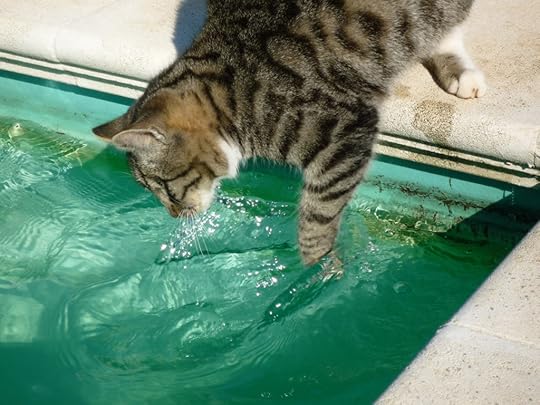 Some cats also enjoy water so be sure your pool is fenced and that your furry friend learns how to get out of the pool, fountain, or other waterway that the two of you visit.
Some cats also enjoy water so be sure your pool is fenced and that your furry friend learns how to get out of the pool, fountain, or other waterway that the two of you visit.For more information and tips on water safety and pets, visit this WebMD site: https://pets.webmd.com/dogs/pets-water-safety#1
 Being on the water with a furry friend can be fun for both people and pets — ensure you both are safe as much as possible for a more enjoyable adventure.
Being on the water with a furry friend can be fun for both people and pets — ensure you both are safe as much as possible for a more enjoyable adventure.July 15, 2020
Helping Pet Owners
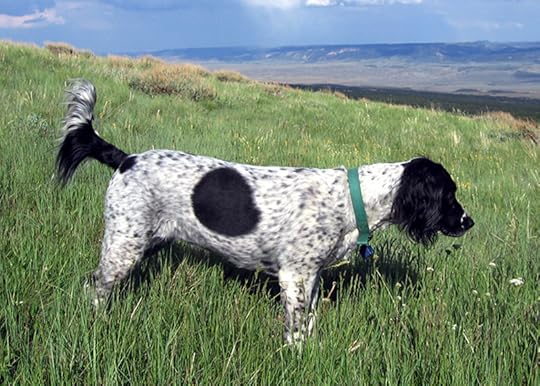 My blind dog Sage inspired many people, especially children, through the books and stories I composed about her. She taught me, and hundreds of others, vaulable life lessons.
My blind dog Sage inspired many people, especially children, through the books and stories I composed about her. She taught me, and hundreds of others, vaulable life lessons.Recently, my husband and I spent an evening observing the comet now encircling the sun. As we prepared to look through binoculars, a woman standing nearby asked, “Did you have a blind dog several years ago?” I looked at her and affirmed her question, and then asked, “How did you know?” She responded, “I contacted you when my dog was going blind. You shared such helpful information. I also got your guidebook for owners of blind dogs.
Her words were encouraging and made me smile. Sage, the blind springer spaniel who lived with my husband and me for more than a decade, inspired several books, including two children’s works, three devotionals, and that guidebook for owners of blind dogs the woman mentioned.
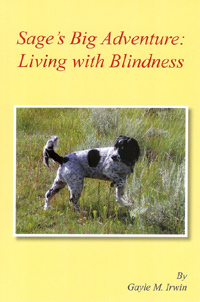 Sage’s Big Adventure: Living With Blindness is a chapter books that teaches kids (and adults) how to face life challenges with perseverance and courage.
Sage’s Big Adventure: Living With Blindness is a chapter books that teaches kids (and adults) how to face life challenges with perseverance and courage.Sage’s Big Adventure: Living with Blindness is a chapter book that helps elementary-aged children to meet life challenges with courage and perseverance, just as Sage lived with blindness with those traits. Sage Finds Friends is a young children’s story about the importance of trust and friendship, and Walking in Trust: Lessons Learned with my Blind Dog is a devotional style book that highlights 30 life and faith lessons, such as courage, faith, perseverance, joy, gratitude, and compassion. Help! My Dog is Going Blind – Now What Do I Do? is a guidebook for owners of blind dogs, helping them navigate the pathway of their dog’s diagnosis. I also have shared different aspects of Sage’s story in a few editions of the Chicken Soup for the Soul series.
You can find more information on my books on my Amazon Author Central page: amazon.com/author/gayleirwin
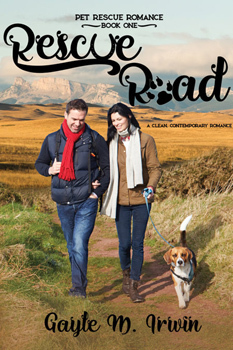 Whether writing for entertainment or specific knowledge, I try to weave important lessons about pets into my books and stories.
Whether writing for entertainment or specific knowledge, I try to weave important lessons about pets into my books and stories.I’ve been a writer nearly 30 years, serving as a journalist, editor, freelance writer, blogger, and author. My favorite subjects are dogs, cats, pet rescue, and pet adoption. That’s what this blog is all about. I enjoy helping people understand the importance of pet adoption and caring for our furry friends. I share information I hope others will find helpful – I also write books to entertain, whether that’s a story for children or my new line of Pet Rescue Romance novels.
As pet owners, we need helpful and encouraging information. Whether that’s how to potty-train a puppy, introducing a new pet into the home, keeping a senior pet happy and healthy, or how to help a pet that’s going blind, we rely on the experience and knowledge of others. I’ve been a pet owner since childhood (with a break during my early college years). I’ve lived with kittens, adopted young adult dogs, and experience the aging process of both dogs and cats. I worked at two different humane societies and I continue to volunteer with rescue organizations. I enjoy sharing my knowledge and experience with others, hoping to help pet owners in a variety of ways.
 This guidebook encourages and helps dog owners who have learned their beloved pet is going blind. Available on Amazon Kindle.
This guidebook encourages and helps dog owners who have learned their beloved pet is going blind. Available on Amazon Kindle.I hope you find this weekly blog of interest and assistance as you live life with your pet(s). Feel free to comment on pet-related topics you’d like to see on my blog in the future – I want to meet the needs of and answer questions from my readers. Leave a comment below.
Also, if you or someone you know has a blind dog and you think that person (or you) could benefit from my inexpensive Kindle book Help! My Dog is Going Blind – Now What Do I Do?, below is a link to that specific book, which is only available via Kindle right now: https://www.amazon.com/dp/B00KKBZS42
July 8, 2020
Choosing a Quality Pet Food Takes Research
 What we feed our pets matters for their health and longevity.
What we feed our pets matters for their health and longevity.When feeding time comes around, does what your pet eats matter? The answer is a resounding YES! Their health, including length of life, depends a lot of what they eat.
My two cats, who are nearly 15 years of age, are finicky eaters. Not only do I have to buy food they like, but it also needs to be good for them. Balancing both can be tricky. Even so-called ‘good brands’ have experienced recalls. Just last week, Natural Balance Ultra–Premium Chicken & Liver Paté formula canned cat food was voluntarily recalled by parent company J.M. Smucker because of elevated levels of choline chloride. Salmonella, Listeria, Vitamin D, even poisons and medications like phenobarbital have made it into commercial dog and cat food. Whether the pet food is dry, canned, or raw, recalls take place; at times, treats have been recalled as well.
 Treats and food made in other countries, like China, can contain ingredients harmful to our pets; many have been recalled over the years, and some stores have stopped carrying pet food and treats made in China. Yet, American-made items also experience recalls. Research is key to knowing what brands to buy.
Treats and food made in other countries, like China, can contain ingredients harmful to our pets; many have been recalled over the years, and some stores have stopped carrying pet food and treats made in China. Yet, American-made items also experience recalls. Research is key to knowing what brands to buy.One brand, FreshPet, a grain-free semi-cooked pet food that is refrigerated, has never experienced a recall. My husband and I purchased this product last year when our springer spaniel, Mary was diagnosed with cancer. Upon reading the ingredients found in the grain-free turkey roll, I discovered many positive ingredients, such as blueberries and spinach, which are recommended in a cancer diet for pets … and is good for pets in general. FreshPet is found in many stores (but not necessarily the grain-free turkey food).
If you read reviews on pet foods, you can find positive and negative ones for nearly any brand. Choosing a pet food is not necessarily easy.
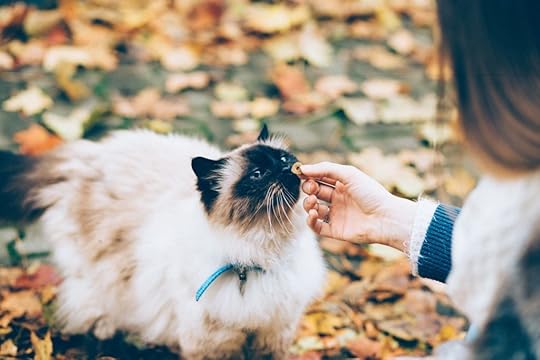 As pet parents, it’s up to us to wisely choose what we feed our pets.
As pet parents, it’s up to us to wisely choose what we feed our pets.We pet parents to conduct research and not just buy a food product because “that’s what we’ve always fed our animals.” Talk with other pet owners. Talk with your veterinarian. Do online research. Sites such as DogFoodAdvisor.com and Petful.com can help you find good food for your pets. These and other sites including the American Veterinary Medical Association (AVMA) and the Federal Food & Drug Administration (FDA), also list pet food recalls, which is important information to know.
Even if you feed your pet “human food,” such as chicken, beef, and turkey, spinach, blueberries, and kale, you should keep an eye open and an ear to the ground regarding recalls and alerts (remember the Romaine Lettuce problem from a few years ago?) These foods can also become contaminated with E. coli, Salmonella, and other bad things. I thoroughly wash vegetables and fruits and cook meats before feeding such things to my dog just as I do before eating these products myself.
Whether you feed your pet kibble, canned pet food, raw, or partially cooked human food, do your homework – research, investigate, discuss, and then choose what you think is best for your furry friend. Even if you pay more to feed your pet, a trip to the veterinarian and the potential (or actual) loss of your companion are much higher costs than providing the healthiest diet possible.
 Conduct research online, read labels, talk to pet supply retailers, your vet, and other pet owners to discover the treats and foods best for your pet.
Conduct research online, read labels, talk to pet supply retailers, your vet, and other pet owners to discover the treats and foods best for your pet.For more information as well as guides on buying pet food and discovering which foods have recalls, visit the following sites:
https://yourdogadvisor.com/best-dog-food/
https://www.wwwallaboutcats.com/best-cat-food
https://www.dogfoodadvisor.com/
July 1, 2020
5 Outdoor Cooking Safety Tips for Pet Parents
 Dogs enjoy the smell and taste of grilled meats just like many humans.
Dogs enjoy the smell and taste of grilled meats just like many humans.With the July 4th holiday weekend fast approaching, many people will celebrate with a fun tradition: outdoor cooking.
From gas and charcoal grills to picnics in the park, the enjoyment of cooking and eating outdoors is not lost on people or their pets. Sizzling steaks and burgers, hotdogs over the campfire, and fresh fruits and veggies on the table make everyone’s mouths water … including our furry friends’.
However, before you fire up the flames, keep these five tips in mind to keep your beloved four-footed companion safe:
Guard your grill. Dogs especially can hardly resist the opportunity to snatch a steak, burger, or hotdog. Some of the spices and rubs we humans put on our meats can be bad for our pets. There are many types of human foods our pets should not eat, and alcoholic drinks can cause health problems as well. For more information on this topic, visit the ASPCA website: https://www.aspca.org/pet-care/animal-poison-control/people-foods-avoid-feeding-your-pets. Also, grill cleaners, lighter fluid, and charcoal briquettes can gravely harm our furry friends if accidently ingested.Make sure there’s plenty of water and shade. Both people and pets need to stay hydrated, and the best way to do so is by drinking plenty of water. Ensure your pet’s bowl is filled throughout the time s/he is outdoors and that s/he has a shady place to rest and get out of the heat. Pets can fall victim to heat exhaustion and heat stroke, just like people.Be attentive when using citronella torches. Although we want to keep bugs at bay while outside, the fluid commonly used in citronella torches can harm pets. Therefore, if fluid spills, keep your pet far away. Ingesting the fluid can cause gastrointestinal upset or worse, and if your dog or cat walks through the liquid or rolls in it, skin irritation or chemical burns can result.Be mindful of sunscreen. Although sunscreens for pets are available, ones made for people should not be used on our furry family members. If your dog or cats licks or eats such products, s/he can become very ill.Don’t let the dog (or cat) out – and ensure your pet’s ID is up-to-date. When spending time in the backyard, make sure the gates of your fence are secure and/or that your back door is tightly closed. Pets can easily slip through open doors and gates, get out to the street, and … well, none of us wants to think about lost pets (or worse). However, in case your pet does get away during a backyard barbecue, especially this holiday weekend, the chances of him/her returning are much better if s/he is wearing a collar and ID tags with accurate information (microchip is also a good idea, and again, ensure your contact information is current).
 Make sure your pet’s microchip and/or ID tag information is up-to-date in case your furry friend escapes or is outdoors. Lost and stray animal numbers increase during the 4th of July holiday, and it’s easier for them to get home when wearing identification that is current.
Make sure your pet’s microchip and/or ID tag information is up-to-date in case your furry friend escapes or is outdoors. Lost and stray animal numbers increase during the 4th of July holiday, and it’s easier for them to get home when wearing identification that is current.With fireworks and other loud noises that usually take place during the 4th of July, your pet’s safety is crucial, whether firing up the grill or not. Animals that are sensitive to noises need special care, whether that’s a room outfitted with toys and a blanket, applying a Thundershirt® or providing calming tablets. This holiday seems to have the greatest number of escaped/stray pets than any other time of year; therefore, provide extra security for your pets and make sure their ID tag and microchip information are current.
Enjoy the holiday weekend and spending time outside this summer, but remember these tips to have a good, less worrisome time when it comes to outdoor cooking and pet safety.
For more tips on outdoor cooking and pet safety, visit this Petfinder site: https://www.petfinder.com/dogs/living-with-your-dog/gallery-10-tips-to-protect-dogs-at-cookouts-summersafetytips/
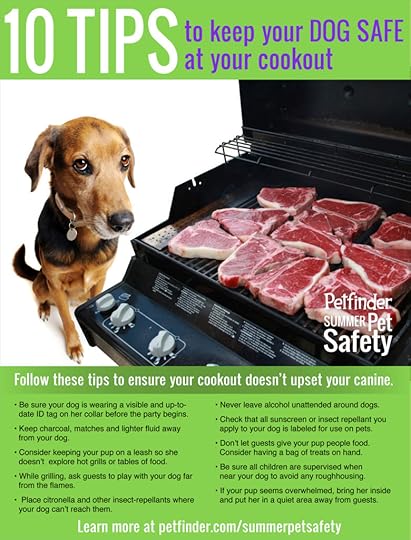
June 25, 2020
Things to Know About Lyme Disease
 Hiking, camping, backpacking, even walking through the woods can cause you and your pet to pick up ticks, many of which cause problems like Lyme disease. Be aware and be prepared!
Hiking, camping, backpacking, even walking through the woods can cause you and your pet to pick up ticks, many of which cause problems like Lyme disease. Be aware and be prepared!With summer in full swing and many of us anticipating more time outdoors, we would be wise to know more about Lyme disease, an affliction that affects both people and pets.
Lyme Disease in Humans
According to the CDC (Centers for Disease Control), about 30,000 cases of Lyme disease in people are reported annually across the United States. However, the CDC believes as many as 10 times that number (or 300,000) could actually be infected.
The most prevalent areas in America for this illness, according to the CDC, are “the Northeast and upper Midwest, with 14 states accounting for over 96% of cases reported to CDC.” Another area known for the disease is northern California.
Black-legged ticks, also known as deer ticks, are the culprits for infecting someone with Lyme disease. Symptoms of this illness for humans include fever, rash, facial paralysis, and arthritis. Left untreated, the illness can spread to a person’s joints, heart, and nervous system.
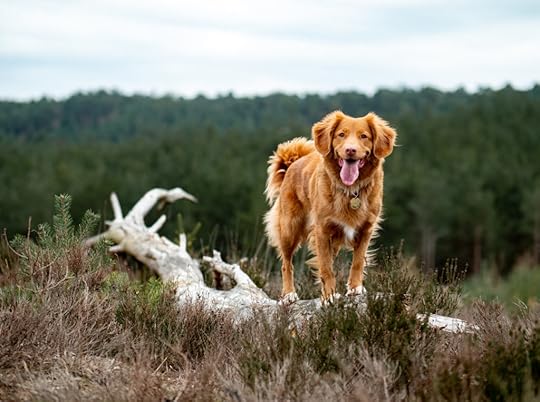 Woodland and marshy areas of America’s northeastern and midwestern states are primary areas for the wood tick, which is the culprit of Lyme disease.
Woodland and marshy areas of America’s northeastern and midwestern states are primary areas for the wood tick, which is the culprit of Lyme disease.Lyme Disease in Pets
Ticks not only attach to people, but also to animals. Lyme disease gets into the bloodstream of people and animals through the bite and attachment of a deer tick. The bacteria often travels to various parts of the body, causing problems in organs, joints, and other areas.
Veterinarians recommend pet owners check their pets for ticks every time their animals are outdoors and to remove the tiny, pesky creatures as soon as they are found. Preventative care is also advised. There are many anti-tick products available, therefore, talk with your veterinarian about the best choice for the area in which you live and for your particular pet.
According to the ASPCA (American Society for the Prevention of Cruelty to Animals), infected pets may not show symptoms of Lyme disease for two to five months. Symptoms include fever, swollen lymph nodes, fatigue, loss of appetite, joint swelling, and lameness. Our pets can also experience decreased activity and kidney problems.
Veterinarians use two different blood tests to confirm Lyme disease in pets. Treatment for the illness includes use of antibiotics for at least 30 days, longer if the illness persists.
Although Lyme disease is not common in cats, if they roam outdoors for any length of time in tick-infested areas, felines can become infected if ticks are not removed. Lameness is a common symptom that cat owners may notice, but sometimes cats don’t exhibit any problems if they are infected.
There are other illnesses spread by ticks, depending on the area of residence and the type of ticks that inhabit those regions.
 Although cats aren’t as likely to get Lyme disease as dogs, talk with your vet about the benefits of tick
Although cats aren’t as likely to get Lyme disease as dogs, talk with your vet about the benefits of tickprevention for your feline friend.
Can People Get Lyme Disease From Their Pets?
According to the CDC, “Although dogs and cats can get Lyme disease, there is no evidence that they spread the disease directly to their owners. However, pets can bring infected ticks into your home or yard. Consider protecting your pet, and possibly yourself, through the use of tick control products for animals.”
Lyme disease is a serious illness for people and animals. Therefore, do your best to protect yourself and your furry friends from ticks.
For more information on Lyme disease and pets, visit the American Veterinary Medical Association website for a special pet owners’ guide: https://www.avma.org/resources/pet-owners/petcare/lyme-disease-pet-owners-guide.
 Protect yourself and your pets from ticks and the diseases they carry.
Protect yourself and your pets from ticks and the diseases they carry.June 17, 2020
Summer Celebration Pet Safety Tips

Summer officially begins on Saturday, and Father’s Day is celebrated in America on Sunday. With warm weather and longer daylight hours, many festivities and activities will take place this weekend and during the next few months, including outdoor events like grilling, boating, fishing, and camping. How do these activities affect our pets? Let’s take a look:
Barbecues and Picnics: Food not only appeals to people, but also to our pets. Charcoal and gas grills welcome burgers, hot dogs, steaks, and other sizzling, delicious dishes. Keep your animals away from grills to keep them safe from burns and other hazards. Also, picnic items that sit out, especially those with mayonnaise and butter, can be tempting for our pets, but just as they can be harmful to us sitting in the sun, these items can also be harmful to our animals’ health.Water Sports: From blue-green algae growing in lakes to rushing rivers that can drown, water presents hazards to our pets. Life vests designed for dogs and cats help keep them safe when you’re around water. No matter if you swim, boat, canoe, kayak, paddleboard, or fish, make your pets’ safety a priority while you and your furry friend enjoy water activities!Camping: Whether you and your family sleep in a tent or in a RV, spending the night (or weekend or week) outdoors can be fun. Star-gazing, marshmallow roasting, and singing around the campfire bonds people and make for great memories. If you take your furry friends along for the outing, keep them safe from fire and from creatures of the night, such as owls, skunks, and raccoons. Rabies can be passed from one another to another as well as to humans, so ensure the safety of you and your family, including your four-legged friend, by having your pet’s vaccinations up-to-date. Owls can snatch up cats and small dogs, so be sure your pet is always on a leash, which also keeps it from wandering from your campsite and being lost.Hikes and Walks: Taking outdoor walks and hikes is a healthy activity to enjoy outdoors, and during the summer, many people spend time doing just that. Breathing fresh air, strolling along a nature trail, and soaking in beautiful scenery are excellent ways to enjoy the summer and offer bonding time with our furry friends. Be aware of other animals, from snakes and raccoons to other dogs and larger animals such as deer and moose – bites and kicks from such creatures can inflict injury or even death. Consider rattlesnake protection for your pet if you live in or visit areas where such poisonous creatures reside. Also, protect your pets from rabies, as noted above, as well as fleas, mosquitoes and ticks. Talk with your veterinarian about such products.Fireworks: Many celebrations, especially America’s Independence Day (July 4), feature fireworks. Some animals are afraid of such loud noises and bright, flashing lights. Therefore, ensure your pet has a safe area, whether a room in the house or a kennel/crate; you might even try a calming product, such as a Thundershirt, which wraps around the body of a dog or cat. Additionally, make sure your animal cannot escape. Hundreds of pets are lost every year due to fireworks as well as thunderstorms because the noises are terrifying to them. Make sure your pet has identification, whether in the form of ID tags and/or an updated microchip in case it escapes during such celebrations.
 Be cautious when you grill or picnic around your pet and whenever you take your pet outdoors..
Be cautious when you grill or picnic around your pet and whenever you take your pet outdoors..As summer settles upon us for another year, keep your pets safe and healthy so you and your beloved four-legged friend can enjoy the beautiful season together. Summer celebrations are fun, and they are more enjoyable when you know your pet is protected from the harms that can result while being outdoors.
 Make sure your pet has identification in case it gets lost.
Make sure your pet has identification in case it gets lost.
June 9, 2020
Crushing on Cat Books During Adopt-a-Shelter-Cat Month
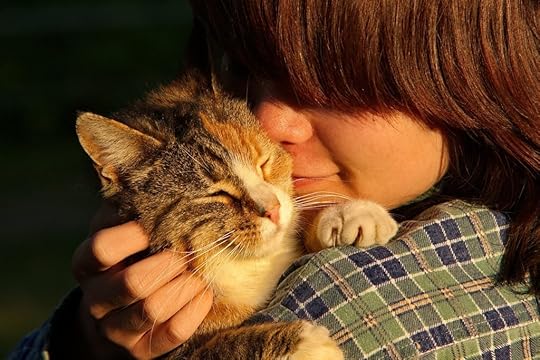 Cats make excellent companions for people, no matter the age of human or feline.
Cats make excellent companions for people, no matter the age of human or feline.I’ve been excited to find new contemporary romance books highlighting rescue animals. One author I recently discovered is Kris Bock. Kris is a prolific writer, crafting not only sweet, contemporary, small-town romance, but also romantic suspense and books for children (she writes kids books under a pen name).
Her sweet romance involves cat rescue and adoption and also includes coffee. Her most recent work in that series is Romance and Rescues at the Cat Café. Two baristas become involved in a rescue of more than 20 cats from a hoarding situation. Due to a snowstorm, they must stay the night in the abandoned house – abandoned except for all the kitties roaming around. In what becomes a dislike-to-like and respect-to-love story, Holly and Dustin work together on behalf of the cats, keeping them fed, watered, and warm until they can take the kitties into rescue. It’s a sweet story not only regarding how attitudes toward each other change, but how the pair help and gain the trust of cats left in the creepy house for goodness knows how long and how the two love on and care for the many disabled felines in the group. Bock shows the mission of rescue through her words, including the feelings and actions of Holly and Dustin, as well as showcases the growth in her characters in understanding of and respect for each other.
 Kris Bock’s series about the Cat Cafe provides delightful reads for those who enjoy sweet romance and pet rescue stories.
Kris Bock’s series about the Cat Cafe provides delightful reads for those who enjoy sweet romance and pet rescue stories.I highly recommend this book if you enjoy stories about pet rescue (especially cats) and sweet love stories.
Kris has also written other books in this series, including Coffee and Crushes at the Cat Café and Kisses and Kittens at the Cat Café; I plan to read both! June is Adopt-a-Shelter-Cat Month, and therefore, a good time to read these books.
 More than 3 million cats and kittens enter animal shelters in the U.S. every year and nearly 860,000 are euthanized. We can all make a positive difference by helping shelters and rescues in some way.
More than 3 million cats and kittens enter animal shelters in the U.S. every year and nearly 860,000 are euthanized. We can all make a positive difference by helping shelters and rescues in some way.Did you know more than three million cats come into animal shelters every year? Two simple things can positively impact that sad statistic: 1.) Spaying/neutering of more cats and 2.) Adoption of more cats. Female cats can breed three times a year, and an average litter is four to six kittens. If none of her offspring are spayed/neutered, between all of them, they can produce more than 400,000 animals. The importance of spaying and neutering cats (and dogs!) cannot be emphasized enough. Even though the number of animal adoptions has increased over the years, (1.6 million cats and about the same number of dogs), still about 860,000 cats are euthanized. More spaying and neutering and more adoptions would bring both numbers down even farther.
Take the time this month not only to read fun romantic cat books like Kris Bock’s works but to help make a positive impact on shelter cats. That can be done by donating money or supplies, by encouraging adoptions (or being an adopter or foster), and by educating people on the importance of spaying and neutering.

Learn more about Kris Bock and her books here: https://www.krisbock.com/bio



